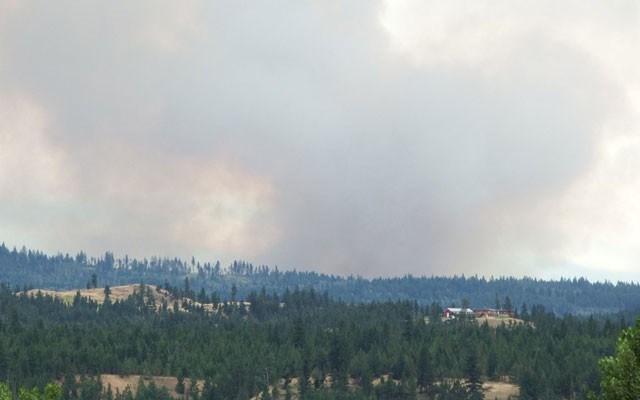It's true there are trees so close to my house you can reach out and touch them.
I can sit on my deck and see birds singing in the branches just a few metres away; I see chipmunks race from tree to tree, hear them squeak in indignation as my cats stare up at them hungrily or a crow steals a good seed pod away.
Looking up and down my neighbourhood road there are scores of mature trees lining the street, and older houses are well settled into green alcoves of forest.
It is truly a mature and lovely area.
But recently, the natural beauty has been haunting me in a different way. How easy would it be for my beautiful evergreen trees, no doubt hundreds of years old, to drip fire onto my deck, sending our home up in smoke?
Suddenly, the enveloping forest feels oppressive and not so much an oasis of green and peace in my hectic world.
I'm pretty sure I'm not the only one having these thoughts.
Added to this weight of worry is the endless smoke. It's been more than a week since we woke up to the gloom and the somewhat disturbing blood-red sun and moon (I feel like we are living in Mordor!).
Along with the smoke have been soaring temperatures — it's all casting a pall over everyone's plans to enjoy the lakes, the cross-country trails and the bike park.
And underlying all this are thoughts about how the tens of thousands of wildfire evacuees across B.C. are coping with their new reality.
The situation here was brought more sharply into focus during a recent visit to the Okanagan. As we made our way through Kamloops, it was like driving through thick fog. Kamloops' air quality rating was 40 out of 10. Main highways were slow and traffic light; a local coffee shop we always stop at on the way was empty. It had been the same at Cache Creek just a few hours before.
One morning at breakfast, the server apologized to us as the kitchen was out of cooked food for a bit — it turns out it had been that hotel's turn to feed all the wildfire fighters. "No problem," I said, noticing the flow of men and women heading out the front door and back to the front lines.
Heading back to Whistler the next day, we were caught by surprise as a squadron of float planes suddenly flew low over our car dipping down into Monte Lake to gather water. We marvelled at the airmanship and would have cheered the pilots' tight formation. Instead, we saved our cheers for the moment the planes released their watery cargo on a fast-moving fire that had stopped our journey.
The area had been evacuated the day before and one home was destroyed.
It feels like every summer Whistler experiences smoke pollution, though I would hazard that this year is a record.
Is this the new normal for summers now? Wildfires start earlier and all of B.C. is impacted?
There can be little doubt that this will impact tourism in the region. It was no surprise to hear on CBC that visitation to the Sea to Sky Gondola was down 60 per cent last week thanks to the smoke.
In a guest column in the Globe and Mail last month by three different authors, it was stated: "In the past 15 years, high-intensity wildfires have burned through forests altered by mountain pine beetle or decades of fire suppression, often threatening communities that are expanding into wildlands. Wildfire seasons are beginning earlier and summer droughts are more pronounced, likely enhanced by global climate change.
"Given the extent of forests in B.C.'s mountainous terrain, most communities are at risk of burning during a wildfire."
The authors Lori Daniel, an associate professor at the University of British Columbia in the Department of Forest and Conservation Science; Robert Gray, a fire ecologist in Chilliwack, B.C.; and David Bowman, a global expert on pyrogeography in Australia, concluded that, "For many communities in B.C., it is not if, but when, wildfire will pose a threat.
"The necessary home renovations, forest thinning and other mitigation activities require substantive, sustained funding so they can be applied consistently across large areas to ultimately make forests and communities resilient. Leadership and investments from the provincial government are urgently needed to overcome these barriers and enable solutions to safeguard our communities."
Better get my pruners out.




